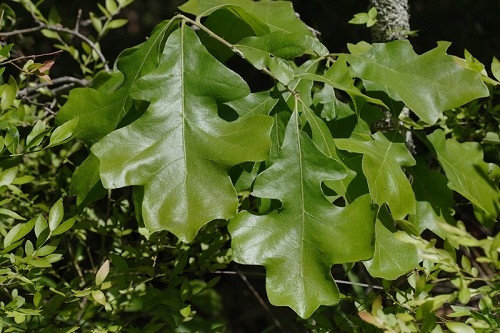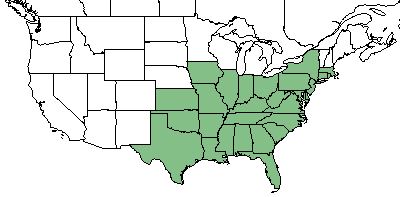Quercus stellata
Common name: post oak [1]
| Quercus stellata | |
|---|---|

| |
| Photo by John Gwaltney hosted at Southeastern Flora.com | |
| Scientific classification | |
| Kingdom: | Plantae |
| Division: | Magnoliophyta - Flowering plants |
| Class: | Magnoliopsida - Dicots |
| Order: | Fagales |
| Family: | Fagaceae |
| Genus: | Quercus |
| Species: | Q. stellata |
| Binomial name | |
| Quercus stellata Wangenheim | |

| |
| Natural range of Quercus stellata from USDA NRCS Plants Database. | |
Contents
Taxonomic Notes
Synonyms: Q. stellata var. stellata; Q. villosa Walter
Varieties: none
Description
Q. stellata is a perennial tree of the Fagaceae family native to North America. [2]
Distribution
Q. stellata is found in the southeastern corner of the United States from Texas to Massachusetts. [2]
Ecology
Habitat
Q. stellata proliferates in uland forests and woodlands, especially in clay or rocky soils and in communities at least formerly exposed to fire. [1]
Phenology
Q. stellata flowers March-May and November. [3] Native, perennial tree to 75.0 feet. Bark usually gray to gray-brown, relatively thick, irregularly fissured with narrow or broad scaly ridges; leaves deciduous, alternate, simple, stellate-hairy on lower surface, usually 5-7 lobed (not bristle tipped), the upper 3 lobes usually being the largest, usually having somewhat of a crosslike appearance; plants monoecious; inflorescences are catkins; fruit is a 1-seeded nut called an acorn, 1-2 clustered, cup enclosing 33-50% of the nut, maturing the first year in the fall. [4]
Fire ecology
Q. stellata is not fire resistant and has medium fire tolerance. [2]
Use by animals
Q. stellata has low palatability for grazing and browsing animals. [2]
Conservation and Management
Q. stellata is listed as a special concern species by the Rhode Island Department of Environmental Management. [2]
Cultivation and restoration
Photo Gallery
References and notes
- ↑ 1.0 1.1 Weakley, A. S. (2015). Flora of the Southern and Mid-Atlantic States. Chapel Hill, NC, University of North Carolina Herbarium.
- ↑ 2.0 2.1 2.2 2.3 2.4 USDA Plant Database https://plants.usda.gov/core/profile?symbol=QUST
- ↑ PanFlora Author: Gil Nelson URL: http://www.gilnelson.com/PanFlora/ Date Accessed: 5/29/18
- ↑ Gee, K. L., et al. (1994). White-tailed deer: their foods and management in the cross timbers. Ardmore, OK, Samuel Roberts Noble Foundation.